The Microsoft Surface Go LTE Review: Unmatched Mobility
by Brett Howse on January 17, 2019 8:00 AM ESTGPU Performance
The Surface Go features the integrated Intel HD Graphics 615 GPU, and here the advantage of going with a Core based Pentium over an Atom based model in the N Series of processors is more dramatic. The Intel HD 615 features the same 24 execution units as a standard U series Core product, but with a slightly lowered maximum GPU frequency of 850 Mhz compared to something like a Kaby Lake based Core i5 which would be around 1.1 GHz. Intel’s Mobile N Series offers only half the execution units in the Celeron models, and 18 in the Pentium Silver N5000.
We already saw some of this performance delta in the system tests, where PCMark showed somewhat dramatic swings comparing the Pentium Gold 4415Y with the Celeron N4100. Tasks which heavily favored the CPU were somewhat close, but those that leveraged the GPU for gaming or content creation showed a pretty large gain with the Pentium Gold.
Let’s not get ahead of ourselves though. Despite offering twice the execution units as an Atom based processor, this is still an integrated Intel GPU, and therefore it’s going to be slow. It just won’t be quite as slow as an Atom.
Since this is a very low-end GPU, we’ve only run it through our synthetic tests.
3DMark
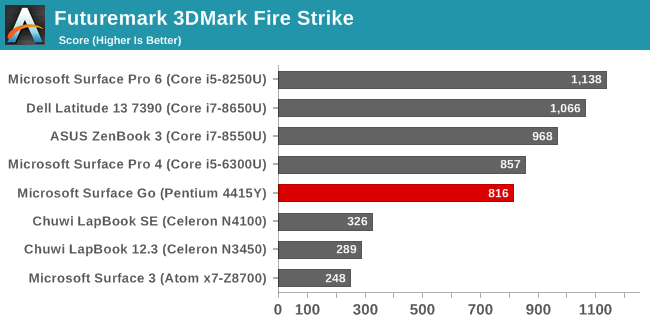
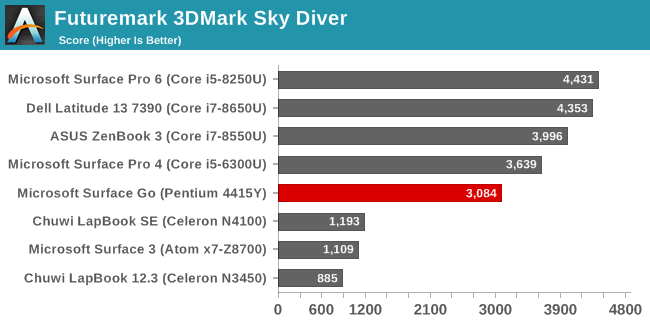

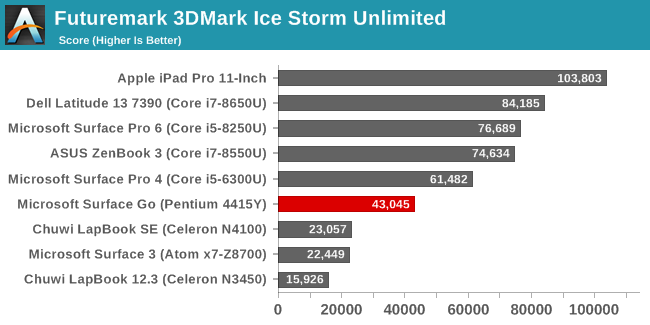
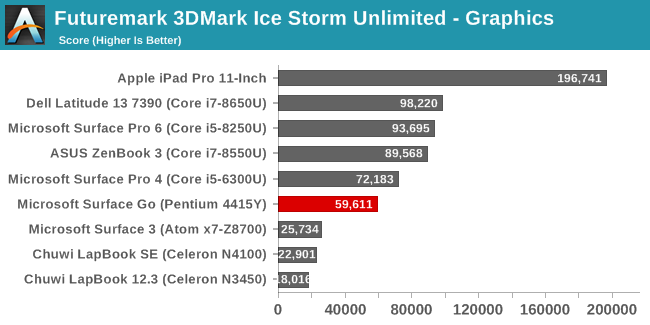
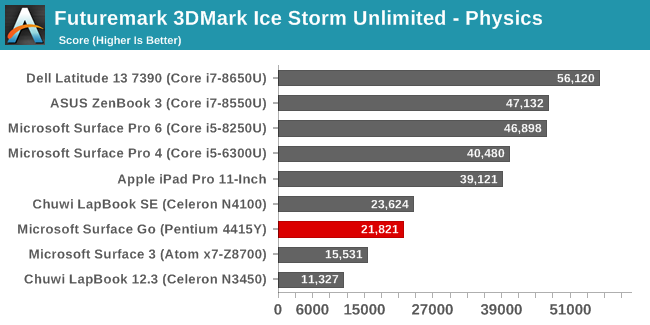
3DMark offers several tests with varying levels of scene complexity, with Fire Strike as the most complex one we run on laptops, followed by Sky Diver, Cloud Gate, and then finally Ice Storm Unlimited which is a test that can also be run on smartphones and tablets.
What’s most interesting is in Fire Strike, if you compare the Kaby Lake based Surface Go with the Skylake based Surface Pro 4, the results are actually quite close. With such a complex scene, the GPU is really the limiting factor more than the CPU, and with both featuring a similar GPU with 24 EUs, the results are really similar, but once the scenes get less complex, the CPU is a larger portion of the task, and the performance drops off fairly dramatically. Ice Storm Unlimited is broken down into the GPU score and the Physics score, with the Physics score being more or less a CPU task, and as we saw on the previous page, the Core i5-6300U is about twice as fast.
Comparing these results to Atom though shows that even though Gemini Lake offers a processor which can meet or beat the Pentium Gold 4415Y, on the GPU side, the meager 12 EUs on Atom are a severe hinderance.
GFXBench
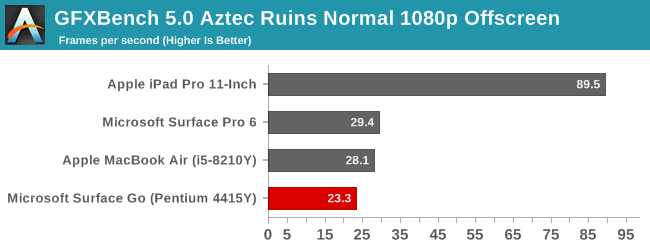
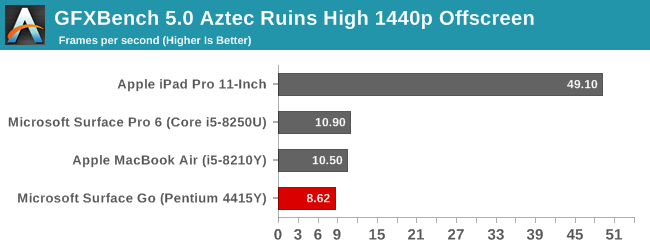
We’re moving over to the latest GFXBench version from Kishonti, which moves away from the OpenGL based tests they offered on Windows, to DirectX 12 with the Aztec Ruins scene. As such, our data is limited, but the results show that the GPU found in the Surface Go is more or less as good as those in higher priced Core offerings, with performance only slightly behind the Surface Pro 6, or even the Y series Apple MacBook Air.
GPU Conclusion
Although the CPU takes a beating when comparing Pentium Gold to Core, the GPU doesn’t suffer the same fate. With the same 24 EUs available as most of the U and Y series Core processors, performance is not hampered quite as much as it is on the CPU side. The overall boost frequency of the GPU is slightly lower compared to a Core i5-6300U, but don’t forget the Pentium Gold 4415Y is also a 6-Watt TDP, so that makes sense. Whereas comparisons on the CPU side with Intel’s latest Atom actually favor the Atom, on the GPU side the Core based Pentium in the Surface Go is much more powerful.
Storage Performance
Microsoft offers two storage offerings in the Surface Go, with the base model being just 64 GB of storage, and the higher tier model features 128 GB. The base model is also eMMC, compared to a true PCIe SSD in the 128 GB model, with the review unit featuring a Toshiba BG3 series. Microsoft moved to a BGA SSD on the Surface Pro in the last couple of models, and the Surface Go also goes with a BGA SSD. That does mean the PCIe interface is just two lanes, which will restrict maximum performance compared to a four-lane model.
The BGA SSD offers good read performance, but write performance with such a small drive takes a big hit. It would be interesting to see this compared to the eMMC version, but we’ve not had a change to test that one. Odds are it would be significantly less performant.


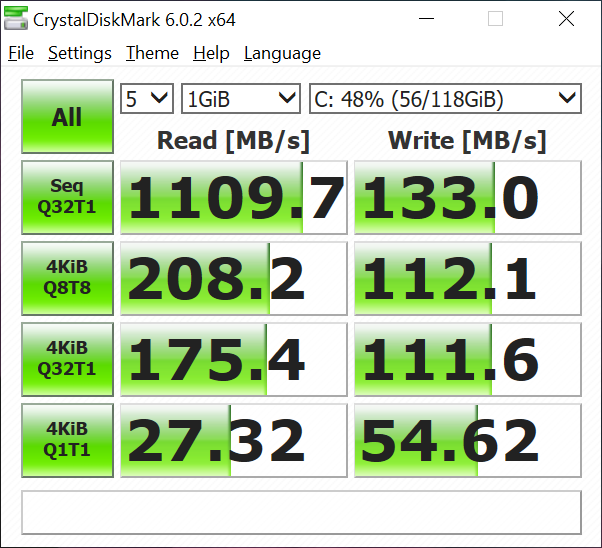








79 Comments
View All Comments
Zeratul56 - Sunday, January 20, 2019 - link
Not everyone can afford multiple devices or even want maintain more than one. While the Go is worse in several areas compared to the ipad(battery, performance) it makes up for it in capabilities.At least in my perspective, the iPad doesn’t do enough to justify its purchase. I had one a few years ago and it was nice but it doesn’t do anything more than an iPhone can.
gglaw - Thursday, January 17, 2019 - link
I honestly can't see why anyone would buy this other than for business with strict requirement for LTE which cost-wise is well out of the budget market for the LTE models. I travel light with an aging Lenovo Miix 510 which is a convertible 12" and it is small *enough* without being severely crippled. Unless that little bit of extra size is just a complete deal breaker, it goes for $500-$550 range for the base i5-7200U and 128GB SSD model and I couldn't tolerate anything weaker than this. It is 1.6mm thicker and 0.8 lbs heavier than the Surface Go which I'm fine with.Going with Intel/Win10 platforms, the hit you take going from 15W CPU's to 6W is not worth it IMO. Comparing with current gen tech you can get up to 4 Ghz with turbo on a 15W Kaby compared to performance more similar to Atom CPU's on these trash Surface Go's. Any business job that requires traveling with access to Windows productivity/office apps should be running a 15W CPU, and if all they need is email, browsing, streaming they should just get an Ipad or Qualcomm based device.
HStewart - Saturday, January 19, 2019 - link
Not if you need real PC applicationssonny73n - Thursday, January 17, 2019 - link
Additional 64GB of SSD storage for $100? And this thing’s battery will last about 5 hours of moderate usage at best. Unmatched mobility for suckers, maybe.ianmills - Thursday, January 17, 2019 - link
You are going to laugh but thats a bargain! For the SP6 to go from 128gb to 256gb is CDN$350I think its because they are a cloud company now. The storage price makes their cloud services seem like a bargain. ;P
TheinsanegamerN - Thursday, January 17, 2019 - link
I am...disappointed. For how much of a dog this thing is, it should deliver amazing battery life, yet gets crushed by the 7390, which is a full proper laptop with a far more powerful chip.I used one in a best buy, and found the experience less then positive. The UI opening new windows, or opening chrome, you could really feel that eMMC storage chugging.
I dont understand how apple can make an ipad with NVMe storage, a way faster SoC, and still get far superior battery life at a lower cost then the Go. I was hoping MS would learn their lessons from the surface 3, but they are making the same mistakes. Sadly nobody else is making a small windows tablet that is any better then the Go.
PeachNCream - Thursday, January 17, 2019 - link
Aside from the iPad there aren't many tablets out there at this point. Microsoft is stubbornly sticking to the Surface line, but I think that's more wishful thinking and an on-going corporate seizure that harkens back to the ill-fated Windows 8 UI changes driving by the attempt to make Windows into a touch-based OS. The bottom line is that tablets are languishing in a tiny niche now that the big fad splash is over. The Surface attempts to recoup all that money tossed into developing user interface paradigms that nobody wanted in the first place.Bausfight - Friday, January 18, 2019 - link
I wouldn't say MS is being stubborn with the Surface line. It's seen strong growth over the years.GreenReaper - Saturday, January 19, 2019 - link
The Surface Go LTE is 1.7lbs while the Latitude 7390 two-in-one is 2.9lbs. If the Go had another pound of battery I'm sure it could crush as well, but it'd be less good for Go-ing places (as long as you expect to be able to charge in those places).dragosmp - Thursday, January 17, 2019 - link
I'm not going to restate what many have already said, but I do have an observation.My 5.5" phone has a 4Ah battery - near enough to 15Wh. This 10" tablet, 4x times the volume, barely has 40% more battery at 24Wh. How does this work? PCB design and packaging technology for PC-compatible bits must be totally backwards compared to mobile. Sure a Core-Y is bigger than a SD660, but dam'. 4x the volume and only 40% more battery, unbelievable.